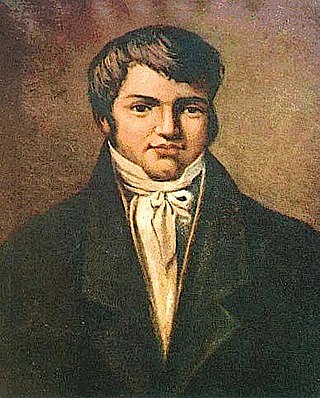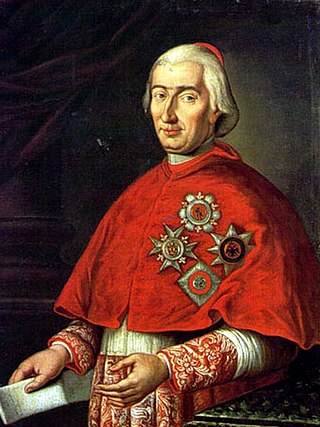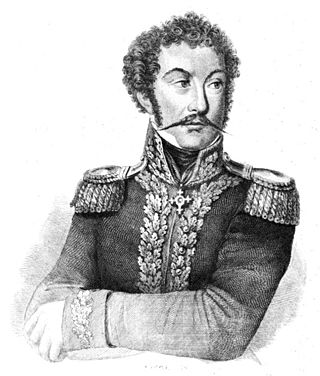
Ferdinand I was the King of the Two Sicilies from 1816, after his restoration following victory in the Napoleonic Wars. Before that he had been, since 1759, Ferdinand IV of the Kingdom of Naples and Ferdinand III of the Kingdom of Sicily. He was deposed twice from the throne of Naples: once by the revolutionary Parthenopean Republic for six months in 1799 and again by Napoleon in 1805, before being restored in 1815.

The Parthenopean Republic or Neapolitan Republic was a short-lived, semi-autonomous republic located within the Kingdom of Naples and supported by the French First Republic. The republic emerged during the French Revolutionary Wars after King Ferdinand IV fled before advancing French troops. The republic existed from 21 January to 13 June 1799, collapsing when Ferdinand returned to restore monarchial authority and forcibly subdued republican activities.

Fra Diavolo, is the popular name given to Michele Pezza, a famous guerrilla leader who resisted the French occupation of Naples, proving an "inspirational practitioner of popular insurrection". Pezza figures prominently in folk lore and fiction. He appears in several works of Alexandre Dumas, including The Last Cavalier: Being the Adventures of Count Sainte-hermine in the Age of Napoleon, not published until 2007 and in Washington Irving's short story "The Inn at Terracina".

The Kingdom of Naples, also known as the Kingdom of Sicily, was a state that ruled the part of the Italian Peninsula south of the Papal States between 1282 and 1816. It was established by the War of the Sicilian Vespers (1282–1302), when the island of Sicily revolted and was conquered by the Crown of Aragon, becoming a separate kingdom also called the Kingdom of Sicily. This left the Neapolitan mainland under the possession of Charles of Anjou. Later, two competing lines of the Angevin family competed for the Kingdom of Naples in the late 14th century, which resulted in the death of Joan I by Charles III of Naples. Charles' daughter Joanna II adopted King Alfonso V of Aragon as heir, who would then unite Naples into his Aragonese dominions in 1442.

Fabrizio Dionigi Ruffo was an Italian cardinal and politician, who led the popular anti-Jacobin Sanfedismo movement.

Pietro Colletta was a Neapolitan general and historian, entered the Neapolitan artillery in 1796 and took part in the campaign against the French in 1798.

Maria Carolina was Queen of Naples and Sicily as the wife of King Ferdinand IV and III, who later became King of the Two Sicilies. As de facto ruler of her husband's kingdoms, Maria Carolina oversaw the promulgation of many reforms, including the revocation of the ban on Freemasonry, the enlargement of the navy under her favorite, Sir John Acton and the expulsion of Spanish influence. She was a proponent of enlightened absolutism until the advent of the French Revolution, when, in order to prevent its ideas gaining currency, she made Naples a police state.

A sister republic was a republic established by French armies or by local revolutionaries and assisted by the First French Republic during the French Revolutionary Wars. These republics, though nominally independent, relied heavily on France for protection, making them more akin to autonomous territories rather than independent states. This became particularly evident after the declaration of the French Empire, when several states were annexed, and the remaining turned into monarchies ruled by members of the Bonaparte family.

Florestano Pepe was an Italian patriot. He was brother to the more famous general Guglielmo Pepe and cousin to Gabriele Pepe.

Giuseppe Maria Rosaroll-Scorza was an Italian essayist and a general in the army of the Kingdom of the Two Sicilies. He was also the father of the Italian patriotic hero Cesare Rosaroll.

Giuseppe Maria Capece Zurlo, Theat. was an Italian cardinal who served as Archbishop of Naples.

Charles Lock was the British consul-general in Naples during the Neapolitan Revolution of 1799.
Vincenzo Russo was an Italian patriot, who was a leading supporter of the short-lived Parthenopean Republic. Captured by the Sanfedista forces, he was soon executed along with many other rebels of the Bourbon rule of Ferdinand IV of Naples.
Luisa Sanfelice is a 2004 Italian historical film directed by Paolo and Vittorio Taviani. It stars Laetitia Casta and was co-produced between Italy and France. It is an adaptation of a book by Alexandre Dumas.

Ettore Carafa d'Andria, the Count of Ruvo was an Italian soldier and republican patriot, executed after the fall of the Parthenopean Republic. His courage, idealism, and resolute optimism created in Ettore an image of the Italian martyr for following generations involved in the struggle for more democratic structures and an Italian nation.
Gennaro Serra, Prince of Cassano was an Italian revolutionary and soldier, who fought for the brief Parthenopean Republic in Naples.

The Altamuran Revolution was a three-month period of self-government of Italian town Altamura, right after the birth of the Parthenopean Republic which ousted the Bourbons and the Kingdom of Naples. The city of the Kingdom of Naples was then defeated and taken by the so-called Sanfedisti, led by cardinal Fabrizio Ruffo, after a battle on the city walls. After being defeated, most Altamurans managed to flee through Porta Bari, one of Altamura's main gates.

Domenico Sacchinelli was an abbot of the Catholic church. He is best known for having followed and helped Fabrizio Ruffo and the Sanfedisti army to restore the Kingdom of Naples and the Bourbon dynasty, after the short-lived Parthenopean Republic (1799). In 1836, after a few decades, he published his memoirs of that period, titled Memorie storiche sulla vita del cardinale Fabrizio Ruffo.

Porta Matera was one of the main gates of the old city of Altamura. They were part of the City Walls of Altamura, which were completely demolished during the nineteenth century since they had become useless for defence purposes. The gate itself was demolished in 1872. The monastery Monastero del Soccorso is located on the left side of the gate, while on the right some ruins of the city walls can be seen, presumably saved from destruction because of the bas-relief depicting "Pipino's leg".
Bourbon Restoration may refer to:



















